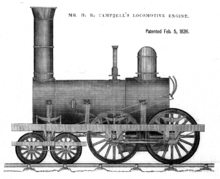American (locomotive)
American ( Standard or Eight-Wheeler ) is the American type designation that is still used in English-speaking countries today for steam locomotives with the UIC wheel arrangement 2B or 2'B or according to Whyte notation 4-4-0, i.e. with a two-axle bogie in front , two coupled axles and no trailing axle .
Surname
The name American was first used in April 1872 in the Railroad Gazette to describe locomotives with this wheel arrangement. Previously, this wheel arrangement was known as standard or eight-wheeler (eight-wheeled four-axle vehicle).
history
The first locomotive of this type was designed by Henry R. Campbell, chief engineer of the Philadelphia, Germantown and Norristown Rail Road . Campbell was granted a patent for the design in February 1836 and began building the first 4-4-0 shortly afterwards.
The Schools class, acquired between 1930 and 1934 by the Southern Railway in southern England, is considered to be the last steam locomotive with this wheel arrangement to be built in Europe.
Web links
Individual evidence
- ↑ a b White, John H., Jr. (1968). A history of the American locomotive; its development: 1830-1880 . New York: Dover Publications, pp. 46ff. ISBN 0-486-23818-0

